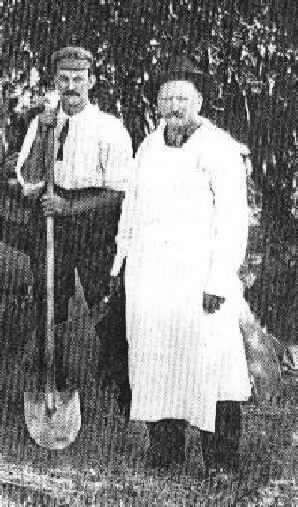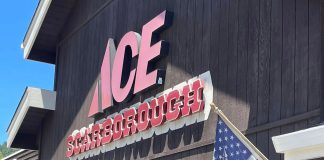The big fire of September 1904 came down from Ben Lomond mountain and crossed the county road, sweeping through the Newell Creek forest and Quail Hollow. On the banks of what was then known as Lumbago Creek, George Fetherston had erected a fine house, where he and his wife Florence were raising two young children—William and Florence.
The San Francisco Chronicle told the rest of the story. “Trackmen on the Narrow Gauge say that for two miles on the Zayante the fire has crossed the track and the train passed between flames that are licking up the forests, farms, and fences….George Featherstone on Lumbago creek lost his home and a quantity of wood, worth $1000.”
The Fetherstons relocated to Felton where they prospered. The elder Florence took charge of a boarding house; and George went into the liquor business. In 1914 the couple bought and renovated the old Creamer hotel. It soon became a favorite destination for movie companies on location in the San Lorenzo Valley. Famous stars raved about Mrs. Fetherston’s pies and, in all likelihood, enjoyed her husband’s extensive stock of whiskey and wine. The early years of Prohibition were very good ones for the Fetherstons. Already the owner of most of Felton’s small downtown, George purchased 700 acres at its undeveloped south end and divided it into suburban lots and, in 1924 he purchased all the stock of the local water company.
Meanwhile, George and his son, William, were active participants in local fire fights. In 1923, after accumulating years of experience with county fire crews, the elder Fetherson served as one of the three commissioners of the newly-formed San Lorenzo Valley Fire District. In September of that year, a dangerous blaze sprang up half a mile from Felton. As reported by the Santa Cruz News: “Deputy Fire Warden Geo. Fetherston upon being notified of the fire lost no time in organizing a force of men who went to the scene of the fire. With no wind blowing the flames were kept from spreading by back firing.”
William Fetherston followed in his father’s footsteps. He was among the crew leaders in 1930 when a blaze near China Grade threatened Big Basin. The local volunteers had a new ally in that fight—rangers from the California Department of Forestry, who appeared on the scene with a new fire truck. The state’s agents had been on the scene since 1926 but had been hampered by a lack of equipment and facilities. What tools the local ranger had on hand were stored in George Fetherston’s barn in Felton.
As luck would have it, better equipment was available. After a raid on a still, the county sheriff had confiscated a 1929 Chevrolet pick up, which he turned over to local fire fighters, who converted it into a pumper truck. The new machine was tested when a brush fire swept through fields near the town of Swanton. Thirty men under the direction of Deputy Warden William Fetherston controlled the blaze before dawn, “assisted materially” by their new Chevrolet truck.”
A new state ranger took charge of the Santa Cruz County district in June 1934. Charles Wilcher brought word that the Forestry Department intended to build a permanent fire suppression station in the area if it could obtain two acres of suitable land. According to the Santa Cruz News: “ Local leaders saw the advantages of having it in Felton and offered land. George Fetherston had two choice acres near the road and reduced the price to $2000. His only stipulation was that a local fire department be formed to raise the money. He didn’t care how long it took.”
In December 1935, the Felton Fire Department was formally organized. Although William Fetherston presided over the meeting, Edward Fox, a former San Francisco fireman served as the group’s first president. The group spent the next two years raising money to pay off their $2000 mortgage. Meanwhile, the new home of the Fire Suppression Unit took shape. “The ranger headquarters,” observed the Sentinel, “consists of a private dwelling for the state ranger, barracks that will house twenty men and a large garage that houses the equipment of the station.” Most of the necessary labor was provided New Deal agencies—especially the WPA and CCC.
In January 1938, the Felton Fire Department mobilized for action. The Santa Cruz papers were pleased to learn that “Bill Fetherston, long recognized as one of the most aggressive and expert fire prevention authorities in the Santa Cruz mountain area, was last night elected chief.”
Chief Fetherston was authorized to select a dozen volunteers, who would learn to operate the Department of Forestry equipment. Frequent drills and exercises were planned. The goal of the local organization was to provide better protection for the town and its residents, including the new homes and summer resorts being built at a rapid pace in the neighborhood.
The Department of Forestry was equipped to fight brush, grass, and forest fires. Fetherston and a committee spent several months deciding what the type of paraphernalia they should buy to enable the use of the state truck to fight structural blazes.
In January 1938, the Felton Fire Department mobilized for action. The Santa Cruz papers were pleased to learn that “Bill Fetherston, long recognized as one of the most aggressive and expert fire prevention authorities in the Santa Cruz mountain area, was last night elected chief.”
Chief Fetherston was authorized to select a dozen volunteers, who would learn to operate the Department of Forestry equipment. Frequent drills and exercises were planned. The goal of the local organization was to provide better protection for the town and its residents, including the new homes and summer resorts being built at a rapid pace in the neighborhood. The Department of Forestry was equipped to fight brush, grass, and forest fires. Fetherston and a committee spent several months deciding what the type of paraphernalia they should buy to enable the use of the state truck to fight house and commercial fires. Their most prominent purchase was a three-section ladder, which, firemen agreed, “could be used both for structural fires and for decoration the Christmas tree the Firemen and Felton Community club put up annually.
Fetherston’s crew faced a dramatic challenge in May 1946, when the two-story wooden building housing Costella’s Lounge burst into flames one morning. Called to duty by the department’s siren, the Felton volunteers raced to the scene. Although the Costella building and two small adjacent structures were lost, the fire fighters rescued Mrs. Costella from the upper floor, then managed to contain the blaze, saving Roy’s Market and the Belardi building on the corner.
Their attention caught, Felton voters overwhelmingly approved the formation of the Felton Fire district in the next election. Each property owner in the district would be assessed 43 cents per $100 assessed value. Assured of funding, the fire department could now purchase a $10,000 fire engine, install fire hydrants and, at a future date, to construct their own fire house “in a central place in Felton.”












